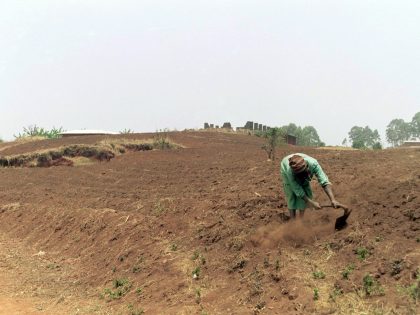Untangling the roots of Empire
The coterie of billionaires and foreign aid agencies intent on transforming African agriculture have mostly upturned people’s lives.

On field drone demonstrations at the Kpong irrigation scheme in Ghana. Image via the CTA ACP-EU on flickr CC BY-SA 2.0 Deed.
Historical figures are so often remembered for the way they died as much as for how they lived, and the hero of the Green Revolution is no exception.
Upon learning he had only days to live, Norman Borlaug, the much-celebrated “Father of the Green Revolution,” who brought chemical fertilizer and insecticide to Asia and Latin America in the 1960s, went silent for a day before finally expressing a few words of regret. “Africa. I failed Africa,” he said, according to a granddaughter. “I never brought a Green Revolution to Africa and I need five more years to do that.”
Only about a year later, in the wake of a global commodity price spike that caused the price of basic food crops to soar across Africa, a new breed of agro-technologists, led by Bill Gates, took up the cause of fulfilling the departed chemist’s last wish. The old, original Green Revolution was relaunched as a “new Green Revolution,” “a Green Revolution for Africa,” or, in the most politically astute iteration, “an African-led Green Revolution,” complete with a new array of innovations like genetically modified seeds (GMOs) and “microinsurance” for small farmers. But in grabbing the torch for itself, the new generation of technocrats ignored everything that had made the first one so disastrous for so many.
Since it began in earnest about 15 years ago, a multitude of projects and policies under the umbrella of an African Green Revolution has upturned lives across the continent with promises to remake the agricultural sector in countries where agriculture is often the only reliable means of survival. Despite sending tremors across the continent, the effort has attracted far less attention from critical scholars and journalists in the US and Europe than it deserves. The journalist Tim Schwab and the sociologist Linsey McGoey included chapters on the Gates Foundation’s involvement in African agriculture in their books on the powerhouse philanthropy, and anthropologist Joeva Rock offered a thorough examination of the history of GMOs in Ghana in her 2020 book We Are Not Starving. Focusing on particular actors or regions, these books have proven important to our understanding of the coterie of billionaires and foreign aid agencies intent on transforming African agriculture, and they’ve also left considerable ground to cover.
In his new book, Seeding Empire: American Philanthrocapital and the Roots of the Green Revolution in Africa, American scholar Aaron Eddens covers a wide swath of history and geography to let in a sliver of light, revealing how the African Green Revolution still carries the blight of the old one.
The myriad projects that made up both the original Green Revolution and the current one playing out in Africa, Eddens writes, “share common narratives that center the agency of White Westerners who bring technology to the agrarian frontier while devaluing the knowledge of indigenous people and smallholder farmers the world over.” Such a simplistic frame of mind has been rich soil for a whole bounty of pseudo-scientific ideas and outright lies that mark out clear divisions “between those deemed most vulnerable and those tasked with saving them.”
As Eddens shows, the divisions that characterize the African Green Revolution were equally present in the first one. In a fascinating chapter set in Mexico, Eddens tells us about an early scouting trip in Mexico, the birthplace of maize, where farmers had developed varieties suitable for the local terrain and climate—called “landraces”—over generations. The plan was to find those well-adapted plants, take them back to the lab, and upgrade them through scientific experimentation for distribution to farmers in corn-growing regions all over the world.
But coming from universities where “race science” and “plant science” were considered related and equally important subjects, the scientists couldn’t help but extend their understanding of plants to the people who grew them, broadly associating indigeneity with poverty and whiteness with wealth and progress—all under the veneer of scientific authority. In one instance, the group highlighted the apparent rise of a new “hybrid race” of mestizos, or people with shared European and indigenous heritage as evidence that Mexico was at long last developing.
Mexico is more than an awkward prologue to the still ongoing rush to “transform” or “fix” African agriculture that followed most of a century later. As Eddens notes, some of the genetic traits in the corn varieties those scientists found in Mexico can now be found in the newer “hybrid” seeds that foreign development NGOs distribute to African farmers today. In what reads like an attempt to quell any criticism of genetic theft that only further underscores the connection, one official from CIMMYT, the Mexican research group that Borlaug co-founded, tells Eddens “the landraces are in the hybrids.”
Seeding Empire is not a comprehensive study of the African Green Revolution and its consequences to date, nor does Eddens present it as one. Instead, it’s a history of the ideas animating that effort. Proponents of the African Green Revolution still cite the essential goodness of Borlaug’s original cause when pressing the moral case for upending the lives and livelihoods of millions of the most vulnerable people on earth. That fact alone makes a critical examination of the original Green Revolution and its ties to the current one important, though it leaves scholars and journalists considerable ground to cover.



